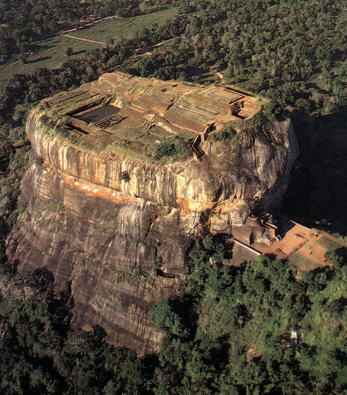| SPECIFICATIONS | |
| Alloy | Brass |
| Type | Struck |
| Diameter | 59.8 mm |
| Thickness | 6.0 mm |
| Weight | ~113 gms |
| Shape | Round |
| Edge | Plain |
| Die Axis | 0° |
| Mint | USSR |


|

| 
| ||||||||||||||||||||
International Council on Monuments and Sites in it's 1981
evaluation said
 In the heart of Lanka, the extraordinary site of Sigiriya - a lofty
rock of reddish gneiss dominating, from a height of nearly 150 meters,
the neighboring plateau -has been inhabited since the 3rd century
B.C., as attested to by the graffiti which proliferate in the grottoes
and the shelters of the Buddhist monks. Yet, the fame of the "Lion
Mountain" is due to one simple factor -during a short period In the
5th century a.d., a sovereign established his capital there. The king
Kassapa I (477-495), son of Datusena, only came to power after he had
engineered the assassination of his father and had, momentarily,
dispossessed his brother. Justly fearing the vengeance of the latter,
Kassapa had a fortified palace built on the rock of Siglrrya which was
reputed to be impregnable. However, it was there that he was defeated
after a a short but cruel battle in 495, following which he cut his
throat. After the death of Kassapa, Moggallana returned the site of
Sigiriya to the monks, thus condemning It to progressive abandon.
In the heart of Lanka, the extraordinary site of Sigiriya - a lofty
rock of reddish gneiss dominating, from a height of nearly 150 meters,
the neighboring plateau -has been inhabited since the 3rd century
B.C., as attested to by the graffiti which proliferate in the grottoes
and the shelters of the Buddhist monks. Yet, the fame of the "Lion
Mountain" is due to one simple factor -during a short period In the
5th century a.d., a sovereign established his capital there. The king
Kassapa I (477-495), son of Datusena, only came to power after he had
engineered the assassination of his father and had, momentarily,
dispossessed his brother. Justly fearing the vengeance of the latter,
Kassapa had a fortified palace built on the rock of Siglrrya which was
reputed to be impregnable. However, it was there that he was defeated
after a a short but cruel battle in 495, following which he cut his
throat. After the death of Kassapa, Moggallana returned the site of
Sigiriya to the monks, thus condemning It to progressive abandon.
During the eleven years that Kassapa resided in Sigiriya, he created a residence of exceptional splendor and founded his capital there impressive vestiges of which are still extant* At the summit of the rock is the fortified palace with its ruined buildings, its cisterns and its rock sculptures. At the foot of the rock, are the two quarters of the lower city which are defended by a massive wall: the eastern quarter perhaps postdating the 5th century, which has not been sufficiently excavated, and the aristocratic quarter of the capital of Kassapa I noteworthy for its terraced gardens embellished by canals and fountains, as well as for numerous monumental remains which have recently been disengaged from the forest which had invaded the ruins.
 Halfway up the rock, within an inaccessible rocky shelter in the
vertical wall of the western facer are rock paintings which have
brought universal acclaim to the site of Sigiriya - The Maidens of the
Clouds", 21 non-identified feminine figures, comparable to the most
beautiful creations of Ajanta.
Halfway up the rock, within an inaccessible rocky shelter in the
vertical wall of the western facer are rock paintings which have
brought universal acclaim to the site of Sigiriya - The Maidens of the
Clouds", 21 non-identified feminine figures, comparable to the most
beautiful creations of Ajanta.
ICOMOS bases its recommendation for the inscription of Sigiriya on the
List on several criteria.
In terms of criterion III, this cultural property is a unique witness
to the civilization of Ceylon during the reign of Kassapa I, Criterion
VI may be involved as well to the extent that an exceptional and
significant historical event was the determining factor in the
creation of the ephemeral capital.
Criterion II, however, offers
the best justification for the request for inscription introduced by
Sri Lanka, On the one hand, the frescoes of Sigiriya inaugurated a
pictorial style which endured over many centuries, On the other, the
site of "Lion Mountain" was visited from the 6th century CE by
passionate admirers. The poems inscribed on the rock by certain of
these admirers. and known by the name "Sigiri graffiti" are among the
most ancient texts in the Sinhala language, and thus show the
considerable influence exerted by the abandoned city of Kassapa I on
both literature and thought.
For a beautiful interactive spherical panoramic views of the grove of apsaras paintings look at images which is one of which is one of 7 images for Ancient city of Sigiriya Heritage site.
The medal which is one of a set of six were minted in 1987 and donated by USSR, to Central Cultural Fund (CCF) probably as a fund raiser.
The Medal was scanned at 300 dpi and displayed at 100 dpi. It was purchased in 2005 March from CCF office in Kandy.